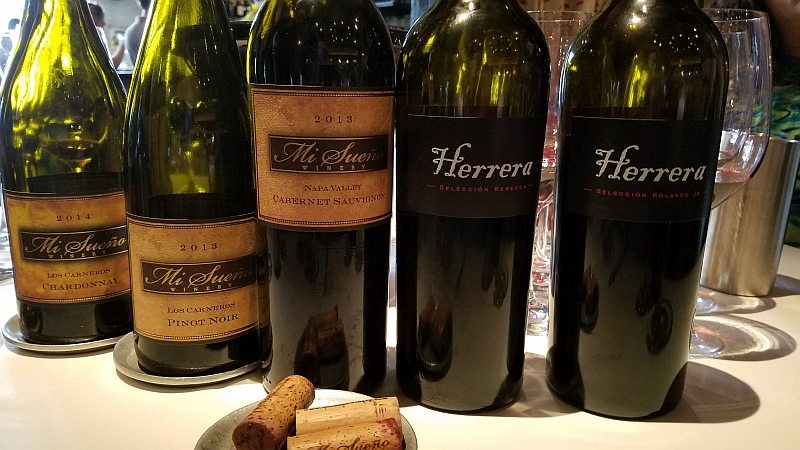“Pull yourself up by your bootstraps” may be an American expression, but often, it’s people like Mexican-born Rolando Herrera who actually live it.
It would not be an exaggeration to say that Herrera came here with little more than his boots. He was eight-years-old in 1975 when his parents brought him from El Llano, Mexico to northern California where they worked in the poultry industry. After five years, his family returned to Mexico, but Rolando’s American dream was ignited.
When he turned 15, Rolando’s father gave him permission to go back to California with his 16-year-old brother. Determined to make his life better, Rolando began as a night dishwasher at Napa Valley’s august Auberge du Soleil, and the nationally acclaimed Mustards Grill while attending high school during the day. At Mustards Grill, he advanced to line cook, but the restaurant walls could not constrain his childhood memories of growing crops in his grandparents’ garden.
In the summer of 1985, Warren Winiarski, owner of the world-famous Stag’s Leap Wine Cellars hired Rolando to break up rocks for a stone wall around the property. With the job complete, and the last year of high school about to begin, Rolando thanked Winiarski for the summer job. Impressed, Winiarski asked him if he wanted to work the harvest and help in the cellar. Although he had no related experience, Rolando accepted the offer with the condition that he work at night, so he could attend school during the day and graduate.
In the wine world’s lexicon, Rolando started as a “cellar rat,” washing tanks, pulling hoses, and doing anything else required to organize the cellar for the avalanche of grapes arriving from the vineyards.
After finishing high school, Rolando continued to work at Stag’s Leap Wine Cellars while taking courses in viticulture and enology at Napa Valley College. Three years later, Winiarski promoted him to cellar master.
With the 1994 harvest competed and the winemaking finished, Rolando accepted a position as assistant winemaker at Napa Valley’s Chateau Potelle, then as winemaker at Vine Cliff Winery. His career path led him in 2001 to Paul Hobbs Wines, a star portfolio of California and Argentine wineries, as director of winemaking.
Two years after he began working at Stag’s Leap Wine Cellars, Rolando began courting Lorena Robledo, herself an infant immigrant of Mexican parents who migrated to Sonoma County as agricultural workers in the 1960s (her parents would go on to own more than 350 acres of vineyards in Napa, Sonoma and Lake Counties). With a shared culture, and lives in agriculture and wine, they married in 1997. Later that year, they founded Mi Sueño (My Dream) Winery making 200 cases of Chardonnay. Today the Herreras farm their 40-acres of estate vineyards spread across Napa and Sonoma appellations.
“We are farmers and winemakers,” Rolando said as the 2014 Mi Sueño Chardonnay Los Carneros Napa Valley was poured at Gramercy Tavern in Manhattan. He farmed the Tierra Blanca vineyard adjacent to the San Pablo Bay to make this gold-tinted wine that has the rich fruit flavors identified with California and the unlikely mouthfeel of Burgundy. Just as surprising: the wine was made with 100% malolactic fermentation, yet without the buttery croissant aroma or taste usually found in California chardonnay that undergoes this process. It was excellent with the chef’s red shrimp appetizer. 94 points. Retail is $42.
From the same vineyard came the translucent black-cherry-colored 2013 Mi Sueño Pinot Noir Los Carneros Napa Valley with its white pepper and black-cherry aromas. Its medium-body carries a mild peppery, red fruit flavor that has a linear feel on the palate. While pleasant, it lacks pinot noir’s usual sensual complexity. 89 points. Retail is $42.
“Warren taught me to be a perfectionist and that’s why I work in my vineyards, and [don’t] use a vineyard management company,” Rolando said. “I like to grow my own grapes and have the final say on them.” I tasted the near-perfect 2013 Mi Sueño Cabernet Sauvignon Napa Valley. Its striking blackberry color is matched by the enticing blackberry, black-pepper and dried-oregano aromas–its elegant texture recalled the cabernet sauvignon-based Sassicaia. The delicious black-fruit flavor lingered on my palate. 96 points. Retail is about $75.
Rolando produces a small quantity (approximately 600 bottles, respectively) of 100% varietal wines named for each of his six children. At our luncheon, he presented two. After tasting them, I thought about the wine world’s descriptors of masculine and feminine wine styles and how appropriate they were to this wine pair. The wines are available only through Mi Seuño’s wine club at $138.
The 2013 Mi Sueño Herrera Rolando Jr. Cabernet Sauvignon Coombsville Napa Valley is from the three-acre Frog Tree Vineyard. It is darker than the eponymous cabernet sauvignon (reviewed above). When tasted immediately after being poured into the glass, the wine displays a very juicy black-cherry character with a mineral backbone. However, 20 minutes of aeration brought strong blackberry, mulberry and vanilla aromas and flavors with noticeable tannins. This is a very structured wine, requiring a few years cellaring to show its best. 92 points.
From the Carpignano vineyard comes the 2013 Mi Sueño Rebecca Cabernet Sauvignon Coombsville Napa Valley with its blackberry, vanilla and milk chocolate aromas. Its black-cherry and cranberry fruit flavors are more accessible than the sibling cabernet sauvignon and the gravelly backbone and tannins are less dramatic. This cabernet sauvignon has a softer, rounder mouthfeel, making it drinkable while the Rolando Jr. is aging. 92 points.
Like earlier generations of dreamers that came to America from across the globe, today the Herreras are living their dream. And we are beneficiaries of it.
Photos by John Foy












Leave A Comment